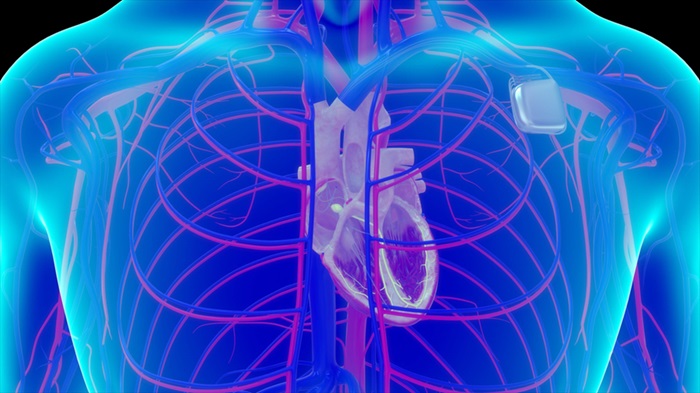Groundbreaking System Combining Leadless Pacemaker with Subcutaneous Defibrillator to Revolutionize Cardiac Care
|
By HospiMedica International staff writers Posted on 02 Jul 2024 |

A major complication with traditional pacemakers and defibrillators is the risk of infection, which may require the removal of the leads—insulated wires that convey electrical impulses to the heart. Additionally, these leads are susceptible to breaking, requiring their removal. Extracting leads is a complex procedure that requires specialized equipment and poses increasing risks the longer the leads are embedded in the body and the more they become integrated with heart tissue and blood vessels. Now, a new system described in an article published in the New England Journal of Medicine, marks a significant advancement in cardiac care and promises safer and more effective treatment for patients.
This groundbreaking system, developed through an international study involving dozens of researchers worldwide, including from the University of Tennessee Health Science Center (Memphis, TN, USA), combines an atrial leadless pacemaker with a novel subcutaneous defibrillator. The new devices aim to eliminate the hazardous complications associated with conventional devices by doing away with the need for lead extraction. The subcutaneous defibrillator is implanted on the left side of the body near the ribcage, with the wire routed subcutaneously and positioned above the sternum, ensuring no contact with the blood pool. Conversely, the leadless pacemaker, roughly the size of an AA battery, is implanted in the leg, led through the femoral vein and attached to the inside of the heart. These two devices communicate wirelessly to correct dangerous cardiac arrhythmias without the need for direct electrical shocks to the heart.
“When the leadless pacemaker sees a dangerous heart rhythm, it can appropriately respond to that event, it can perform antitachycardia pacing, and it can respond back to the defibrillator that it was doing that, so the defibrillator doesn’t shock the patient,” said Harish Manyam, MD, interim chair of the Department of Medicine at the University of Tennessee Health Science Center’s College of Medicine, who was part of the international study that involved dozens of researchers worldwide. “If that doesn’t work, the pacemaker will let the defibrillator know, and the defibrillator itself will shock the patient.”
Related Links:
University of Tennessee Health Science Center
Latest Surgical Techniques News
- Pioneering Sutureless Coronary Bypass Technology to Eliminate Open-Chest Procedures
- Intravascular Imaging for Guiding Stent Implantation Ensures Safer Stenting Procedures
- World's First AI Surgical Guidance Platform Allows Surgeons to Measure Success in Real-Time
- AI-Generated Synthetic Scarred Hearts Aid Atrial Fibrillation Treatment
- New Class of Bioadhesives to Connect Human Tissues to Long-Term Medical Implants
- New Transcatheter Valve Found Safe and Effective for Treating Aortic Regurgitation
- Minimally Invasive Valve Repair Reduces Hospitalizations in Severe Tricuspid Regurgitation Patients
- Tiny Robotic Tools Powered by Magnetic Fields to Enable Minimally Invasive Brain Surgery
- Magnetic Tweezers Make Robotic Surgery Safer and More Precise
- AI-Powered Surgical Planning Tool Improves Pre-Op Planning
- Novel Sensing System Restores Missing Sense of Touch in Minimally Invasive Surgery
- Headset-Based AR Navigation System Improves EVD Placement
- Higher Electrode Density Improves Epilepsy Surgery by Pinpointing Where Seizures Begin
- Open-Source Tool Optimizes Placement of Visual Brain Implants
- Easy-To-Apply Gel Could Prevent Formation of Post-Surgical Abdominal Adhesions
- Groundbreaking Leadless Pacemaker to Prevent Invasive Surgeries for Children
Channels
Surgical Techniques
view channel
Pioneering Sutureless Coronary Bypass Technology to Eliminate Open-Chest Procedures
In patients with coronary artery disease, certain blood vessels may be narrowed or blocked, requiring a stent or a bypass (also known as diversion) to restore blood flow to the heart. Bypass surgeries... Read more
Intravascular Imaging for Guiding Stent Implantation Ensures Safer Stenting Procedures
Patients diagnosed with coronary artery disease, which is caused by plaque accumulation within the arteries leading to chest pain, shortness of breath, and potential heart attacks, frequently undergo percutaneous... Read more
World's First AI Surgical Guidance Platform Allows Surgeons to Measure Success in Real-Time
Surgeons have always faced challenges in measuring their progress toward surgical goals during procedures. Traditionally, obtaining measurements required stepping out of the sterile environment to perform... Read morePatient Care
view channel
Portable Biosensor Platform to Reduce Hospital-Acquired Infections
Approximately 4 million patients in the European Union acquire healthcare-associated infections (HAIs) or nosocomial infections each year, with around 37,000 deaths directly resulting from these infections,... Read moreFirst-Of-Its-Kind Portable Germicidal Light Technology Disinfects High-Touch Clinical Surfaces in Seconds
Reducing healthcare-acquired infections (HAIs) remains a pressing issue within global healthcare systems. In the United States alone, 1.7 million patients contract HAIs annually, leading to approximately... Read more
Surgical Capacity Optimization Solution Helps Hospitals Boost OR Utilization
An innovative solution has the capability to transform surgical capacity utilization by targeting the root cause of surgical block time inefficiencies. Fujitsu Limited’s (Tokyo, Japan) Surgical Capacity... Read more
Game-Changing Innovation in Surgical Instrument Sterilization Significantly Improves OR Throughput
A groundbreaking innovation enables hospitals to significantly improve instrument processing time and throughput in operating rooms (ORs) and sterile processing departments. Turbett Surgical, Inc.... Read moreHealth IT
view channel
Printable Molecule-Selective Nanoparticles Enable Mass Production of Wearable Biosensors
The future of medicine is likely to focus on the personalization of healthcare—understanding exactly what an individual requires and delivering the appropriate combination of nutrients, metabolites, and... Read more
Smartwatches Could Detect Congestive Heart Failure
Diagnosing congestive heart failure (CHF) typically requires expensive and time-consuming imaging techniques like echocardiography, also known as cardiac ultrasound. Previously, detecting CHF by analyzing... Read moreBusiness
view channel
Expanded Collaboration to Transform OR Technology Through AI and Automation
The expansion of an existing collaboration between three leading companies aims to develop artificial intelligence (AI)-driven solutions for smart operating rooms with sophisticated monitoring and automation.... Read more
















